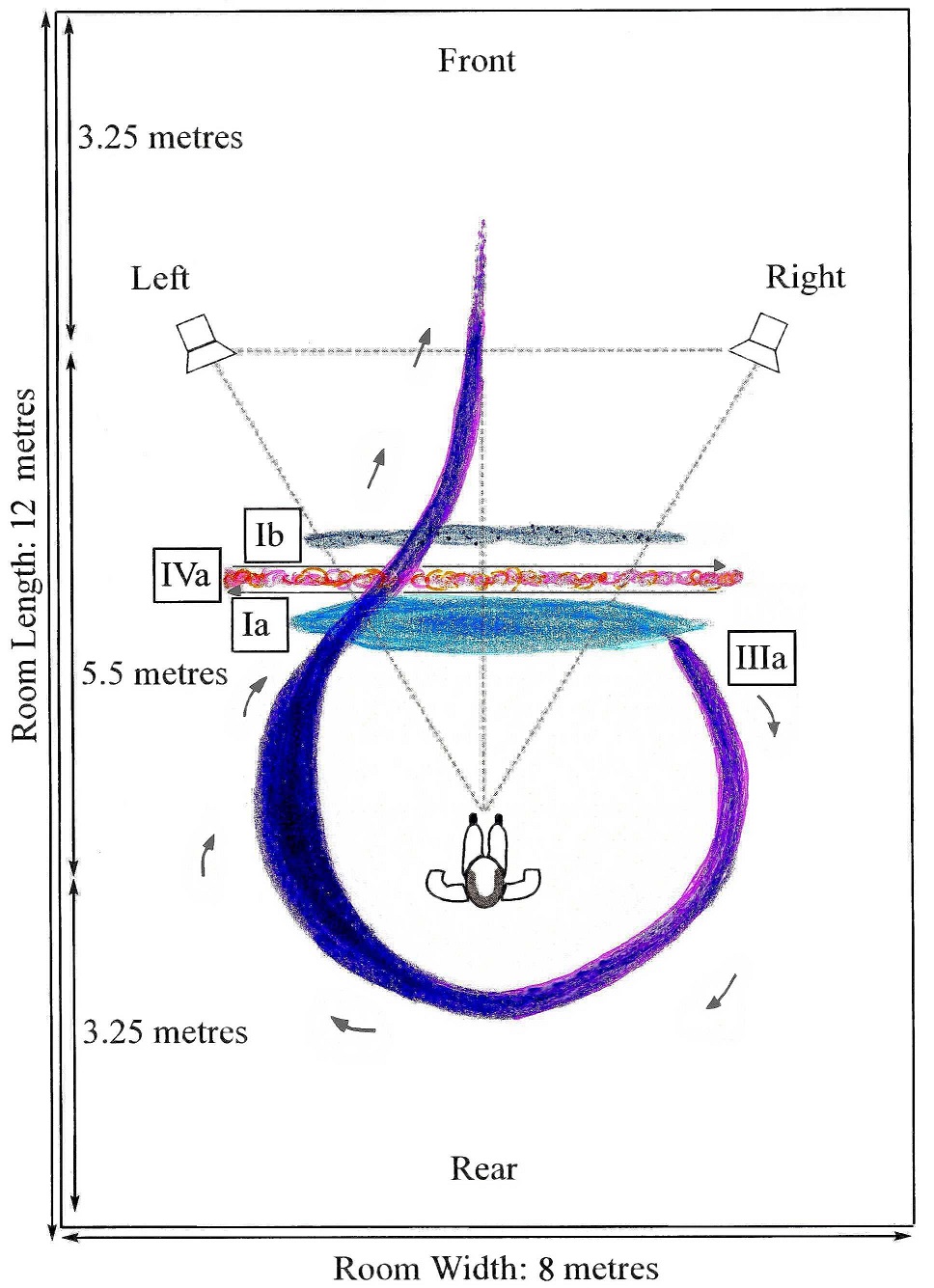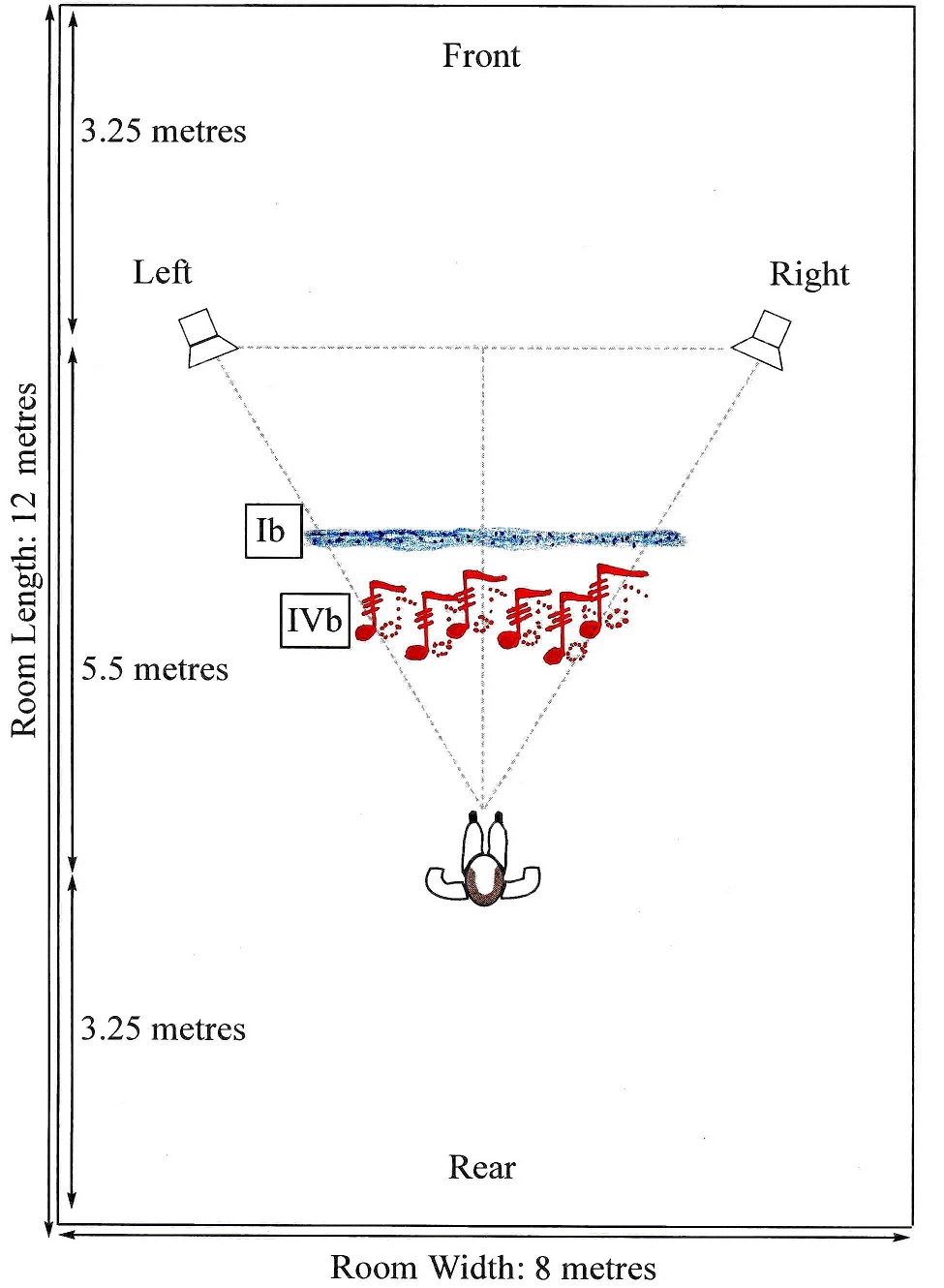3.3.2. Three-dimensional space in Chat Noir

Figure 4. Three-dimensional space in Chat Noir from 3’08” to 3’09” [enlarge]
Sound example 1: Chat Noir 3’08” to 3’14”
(40) L'espace composé dans l'acousmatique stéréophonique

Figure 4. Three-dimensional space in Chat Noir from 3’08” to 3’09” [enlarge]
Sound example 1: Chat Noir 3’08” to 3’14”
(55) La figure 4 illustre la première sous-section (3’08” – 3’09”) dans l’espace tridimensionnel.
Figure 4 illustrates the first subsection (3’08” – 3’09”) in three-dimensional space. (55) If we regard this stereo spatial image as a unified sound-field from the point of view of proximity to the listener – as opposed to the viewpoint of the sounding flow as delivered by the loudspeakers – the transparent, metallic scampering sound (IIa, in green) appears to impregnate the high-pitched, sustained whistling (Ia, in light blue). The two sound-shapes occupy the foreground, relegating the tumbling, chortling repetitive sound (IVa, in pink and orange) and the veil (Ib, in dark blue) – the two pitches of which combine to form one spectromorphology in three-dimensional space – to a more distant location. Sound IVa’s audibility and trajectory across the stereo axis, illustrated by the parallel grey lines with arrows, are largely masked by sounds Ia and IIa. However, IVa has a wider stereo image than the other spectromorphological material in this sound world and, hence, becomes audible when it gravitates to the poles of the stereo axis.

Figure 5. Three-dimensional space in Chat Noir from 3’10” to 3’11” [enlarge]
Sound example 1: Chat Noir 3’08” to 3’14”
(56) La figure 5 illustre l’espace tridimensionnel de 3’10” à 3’11”.
(57) Bien que l’énergie du mouvement de rotation soit d’abord dirigée vers la gauche et puisse sembler réduire l’élan de la pièce, la partie la plus forte de ce son, et le moment de tension maximale, sont perçus dans la seconde partie de la trajectoire, entre l’arrière de l’espace d’écoute et la partie gauche de l’axe stéréo. La tension maximale sur la partie arrière-gauche d’une trajectoire circulaire, dans le sens des aiguilles d’une montre, projette un objet dans le temps ; ici, la rotation, dans une direction opposée, se propulse sur la droite et s’arrête à hauteur d’un axe central, où elle se dissout à la limite du quatrième quadrant, laissant 90° ‘d’espace’ libre pour l’émergence d’un nouvel univers sonore dans un nouveau ‘temps’.
In Figure 5, which represents three-dimensional space from 3’10” to 3’11” (56), the high-pitched, sustained whistling (Ia, in light blue) becomes louder as illustrated by its more opaque morphological design. The veil (Ib, in dark blue) remains in the background, and the tumbling, chortling repetitive sound (IVa, in pink and orange) continues to travel back and forth across the stereo axis. The downward glissando/rotation (IIIa, in purple) is mapped onto three-dimensional space in the form of an incomplete rotation. From my poietico-esthesic perspective, this sound is structurally salient, hence its large dimensions and opaque shade in the figure. Following, the downward glissando/rotation’s 270° trajectory begins at 3 o’clock on an imaginary horizontal clock, and travels in clockwise motion to 12 o’clock. I perceive the trajectory of sound IIIa to begin on the right side of the stereo axis, travel in clockwise motion, swerving behind me, as denoted by the short grey arrows, and brush against the left side of the stereo axis before it shoots forward to the centre-front of the listening space and dissolves.[1] Although the energy motion-trajectory of the rotation, initially, is directed to the left and can appear to restrain the momentum of the piece, the loudest part of this sound, and the place of maximum torque, is perceived in the second quadrant of the sound’s trajectory, between the rear of the listening room and the left side of the stereo axis. Maximum torque on the rear, left side of a circular trajectory in clockwise motion propels an object over time, in this case the rotation, in an opposite direction, centre-rightwards, where it dissolves at the threshold of the fourth quadrant, demarcating 90° of unoccupied ‘space’ for a new sonic universe to begin in a new ‘time’. (57)
This energy-motion trajectory is similar to that of an ocean wave as it crashes on a beach. Water that recedes from a beach is referred to as backflow. Since the wave model is circular, the force and mass of the backflow contribute to the forward thrust of an oncoming wave. We might thus view the first 180° of the trajectory of the rotation in Figure 5 as backflow, which gains force during the trajectory, resulting in the sound being ‘flung’ away from the listener towards the front of the listening room, otherwise viewed as the crest of the wave.

Figure 6. Three-dimensional space in Chat Noir from 3’12” to 3’14” [enlarge]
Sound example 1: Chat Noir 3’08” to 3’14”
(58) La figure 6 illustre l’espace tridimensionnel de 3’12” à 3’14”.
Figure 6 illustrates three-dimensional space from 3’12” to 3’14” (58), the aftermath of the downward glissando rotation. In this virtually barren sonic environment, the veil (Ib, in dark blue) remains stationary, and sound material comprising pitched, lightly fragmented and delayed recordings of a toy accordion (IVb, in red-orange) appears in the foreground distributed evenly across the stereo axis. This material is the harbinger for a new sonic universe that unfolds in the form of an aural kaleidoscope between 3’12” and 4’24”. The first part of the new sonic universe is audible in the last part of sound example 2.
Sound example 2: Chat Noir 2’23” to 3’41”